Protection and treatment of tomatoes from late blight in a greenhouse and open field: the best remedies for late blight on tomatoes
Late blight is one of the most serious fungal diseases that is inherent in plants from the Solanaceae family, especially when it comes to potatoes and tomatoes. Therefore, it is quite obvious that the fight against late blight on tomatoes is not an easy matter, but even a sudden outbreak of late blight on tomatoes can be dealt with.
Next, we will try to figure out what late blight is, what are the reasons for its occurrence, what preventive measures exist, and, of course, how to effectively deal with late blight on tomatoes, by what means.
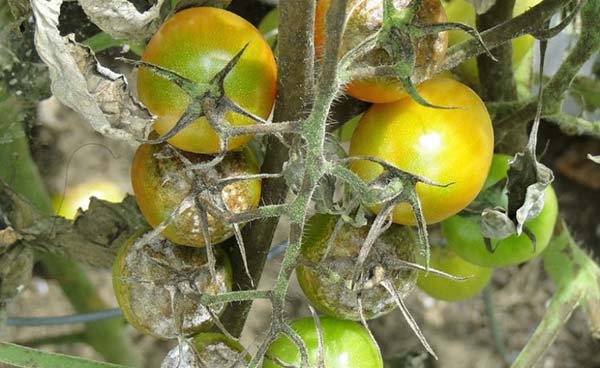
Content
What is late blight on tomatoes and how dangerous is this fungal disease
Late blight, according to many gardeners, is the No. 1 disease for tomatoes and potatoes.
The causative agent of the disease is the fungus Phytophthora infestans.
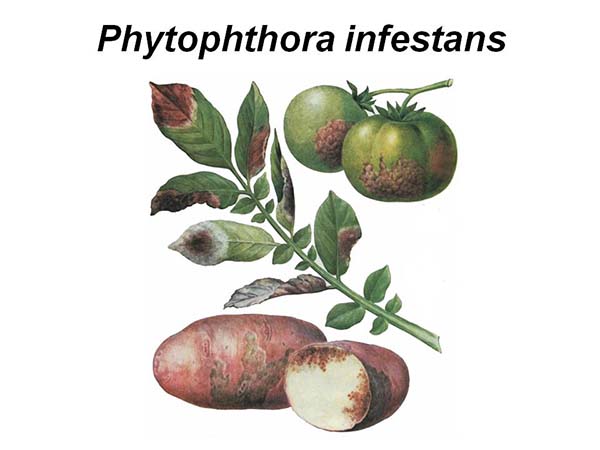
Usually, first signs of illness on tomatoes you can find on the leaves, it is they who begin to bend downward. Further, light greenish spots appear on the damaged areas, which gradually increase in size and acquire a brown color (= dry out). As a result, all the affected areas are connected, the leaf dries out completely and dies (= affected by late blight rot).
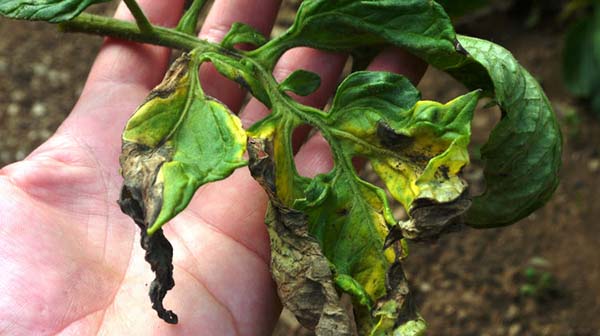
And in wet weather, on the lower (back) side of the leaf, you can see a white bloom of fungal sporulation.
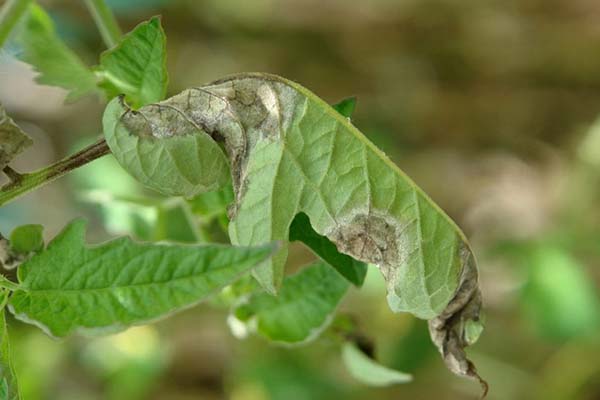
The disease can manifest itself not only on the leaves, but also on the stems, as well as on the fruits themselves.
As a rule, everything starts with the leaves, then the disease spreads to the stems and at the very end - to the fruits.
At different sites stem large dark brown (necrotic) spots also appear, which eventually combine and the bush dries up.
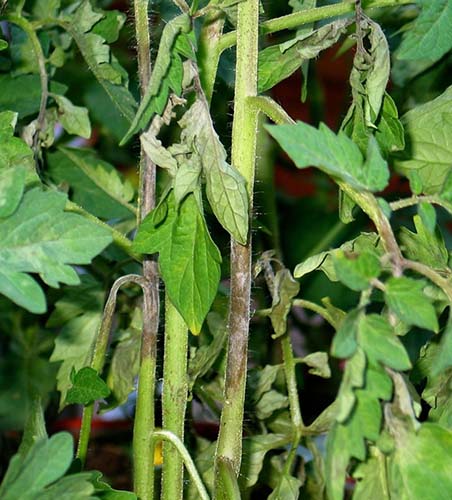
As for the defeat of late blight themselves fruitthen on the tomatoes you can also notice large and hard to the touch, brownish-green (brown) oily spots, which quickly spread to the entire surface of the tomato.
Note! Eat, as well as collect seeds from such fruits - in no case should you!
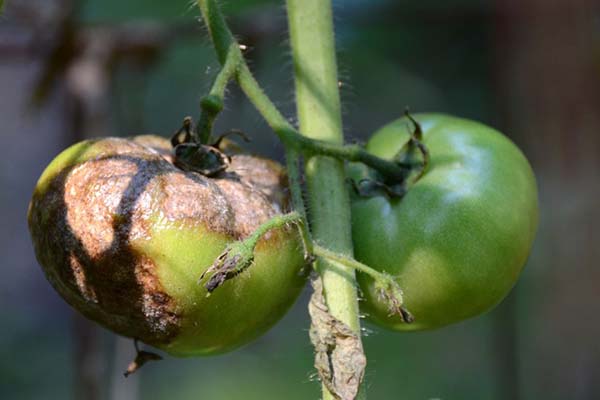
By the way! Spores of the fungus can be carried over long distances by heavy rains in windy weather.
The main danger of late blight is that when favorable conditions for its developmentand this wet and cool weather (prolonged rains, abundant dew, prolonged fogs, which special touches the end of summer-beginning of autumn, when do they start strong fluctuations in day and night temperatures), the disease progresses rapidly and in a short time affects the entire leaf apparatus. Therefore, if do not take action in time, then she (late blight) for several days, simply will destroy all your tomatoes and you will be left without a crop.
Note! It is believed that phytophthora spores are found in any land, and it is activated only from drops of water that fell on the ground and bounced back onto the leaves.
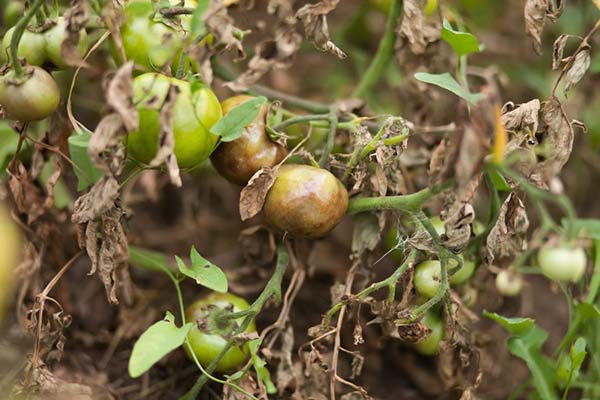
Video: late blight of tomatoes
Measures for the prevention and control of late blight of tomatoes
Next, let's talk about what you can do to prevent the infection of tomatoes with late blight, and how (by what means) you can fight this fungal disease if you have already found traces of it on your bushes.
Prevention methods
Of course, first of all, you need to try to prevent the appearance of late blight in your garden.
- First, it is necessary observe crop rotation (crop rotation rules), namely you cannot plant tomatoes in placewhere last year was grown potatoes or the tomatoes themselves.
- Secondly, not should allow close proximity potato and tomato beds.
The fact is that fungal spores winter well in the soil.
- Every fall is worth carefully clean the greenhouse from plant residues and process after harvest, as well as in the spring before planting seedlings.
By the way! The site has a detailed article on spring preparation of the greenhouse for planting seedlings, as well as material about how to properly process a greenhouse in the fall, after harvest, and prepare for winter.
- When growing tomatoes in the greenhouse need to create favorable conditions for their growth and development, namely, it is imperative to control the humidity (regularly ventilate).
About, how to properly grow tomatoes in a greenhouse, you can read in this detailed material.
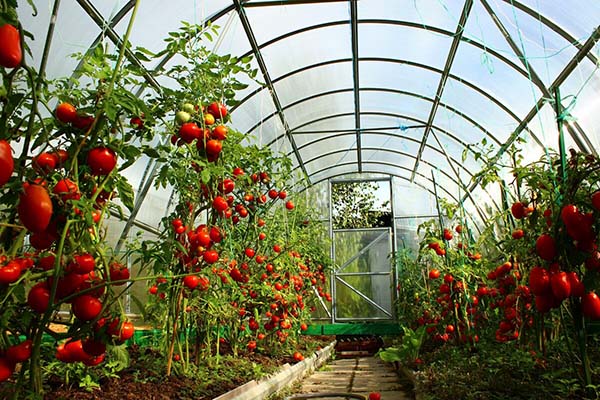
- Proper watering (avoiding splashing water on stems and leaves) and the formation of tomatoes (this is especially true removal of lower leaves) will also help protect tomatoes from late blight.
Note! How to do it right watering tomatoes in the greenhouse and open field, You can find out from this article, a about the formation of tomato bushes - from this material.
- Covering the soil surface with spunbond, balanced nutrition are other important components of prevention.
- If the risk of late blight is very high, then it is advisable to acquire either disease resistant hybrids, or grow early maturing varieties , which manage to give up the entire harvest even before the onset of the late blight period (until the end of summer and early autumn, i.e. August-September).
In other words, late-ripening varieties of tomatoes are most susceptible to late blight.
If you notice the first signs of late blight on tomatoes, then you urgently need to start spraying with chemical or biological fungicides (of course, the sooner the better).
Advice! Actually, you can (and should) start conducting preventive protective spraying during the seedling period (for example, with the drug Previkur Energy), as well as immediately after planting tomatoes into the open ground or greenhouse (i.e. even when the plants show no signs of disease), especially if you know that late blight is likely to appear in your region.
Chemicals
Of course, the most effective way to combat late blight on tomatoes is to treat the bushes with fungicides (drugs against diseases).
Now there are a sufficient number of funds that can really fight late blight.
Alternatively, you can apply either copper-containing products or other contact (which is washed off by the rain), or systemic (penetrate the plant and remain for a certain period) drugs protective and healing action.
Note! Many gardeners have a preconceived notion that the use of chemicals negatively affects (has negative consequences) on the quality of the future harvest and human health. However, this does not correspond to reality, since after the expiration of the waiting period, all harmful substances (pesticides) are removed long before ripening and harvesting.
In contrast to biological products, chemical agents act much faster and more reliably. In addition, the use of chemicals is very often the only way to cure a culture of fungal diseases.
So, the following fungicides are the most effective means for combating late blight on tomatoes (the active ingredients, the method of penetration and the nature of the effect are given in brackets):
By the way! As for when to carry out the first treatment for phytophthora, then, as a rule, they begin to spray already at the budding stage (from the moment the ovaries appear), in the end making about 2-5 treatments, every 7-14 days.
- The most popular copper-containing products are copper sulfate(copper sulfate) and bordeaux mix.
- Hom (Copper oxychloride, protective contact fungicide);
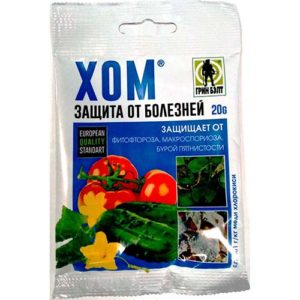
By the way! It is believed that iron vitriol against late blight acts even better than copper.
Recipe: iron vitriol - 50 g, carbamide - 30 g, slaked lime - 20 g per 10 liters of water.
The content of ferrous sulfate in such a solution is only 0.5%, and it is completely non-toxic to plants.
- Oxyhom (Copper oxychloride and Oxadixil, systemic contact fungicide of protective action);
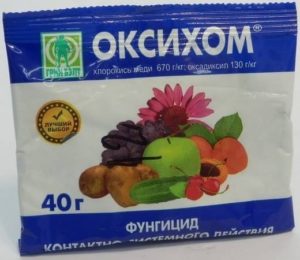
- Ditan M-45 (Mancozeb, contact fungicide of protective action);
- Revus Top (Difenoconazole and Mandipropamide, systemic contact fungicide of protective and healing action);
- Quadris (Azoxystrobin, protective systemic contact fungicide);
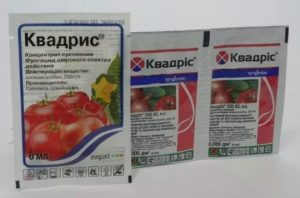
- Infinito (Propamocarb hydrochloride and Fluopicolide, contact-systemic fungicide of protective action);
- Previkur Energy (Propamocarb and Fosetyl aluminum, systemic protective fungicide);
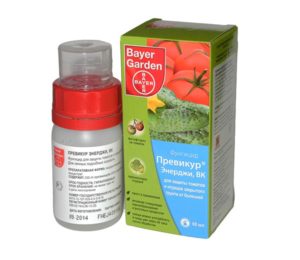
- Consento (Propamocarb hydrochloride and Fenamidone, systemic protective fungicide);
- Metaxil (Mancozeb and Metalaxil, systemic contact protective fungicide);
- Stroby (Kresoxim-methyl, systemic fungicide of protective and healing action);
- Rapid Gold (Mancozeb and Cymoxanil, systemic contact fungicide of protective and healing action);
- Profit Gold (Famoxadon and Cymoxanil, systemic contact fungicide of protective and healing action);
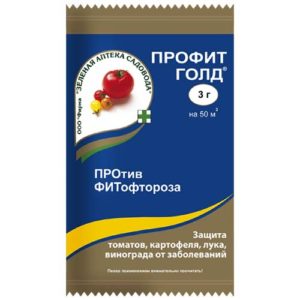
- Ridomil Gold (Mancozeb and Mefenoxam, systemic contact fungicide of protective and healing action);
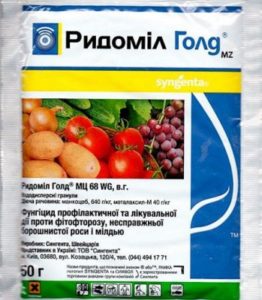
- Ordan (Copper oxychloride and Cymoxanil, systemic contact fungicide of protective and healing action).
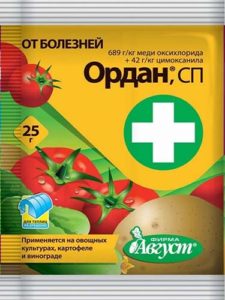
There is also Ordan MC, in which the active ingredients are Mancozeb and Cymoxanil, i.e. in fact, it is Rapid Gold.
- Thanos (Famoxadon and Cymoxanil, systemic contact fungicide of protective and healing action);
Thanos = Profit Gold.
- Acrobat MC (Dimethomorph and Mancozeb, systemic contact fungicide of protective and healing action).
Advice! Treatments should be carried out alternately, with drugs with different active ingredients, so as not to cause addiction and adaptation of the fungus.
Biological agents
Biological drugs that work against late blight on tomatoes include the following:
- Alirin-B (Bacillus subtilis strain B-10 VIZR, systemic contact pesticide of protective, curative and immunizing action);
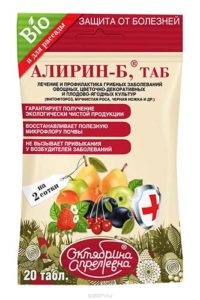
- Gamair (Bacillus subtilis strain M-22 VIZR, systemic contact pesticide of protective, curative and immunizing action);
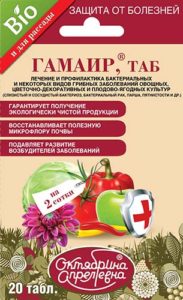
Interesting! The meaning of the immunizing action is that these agents reduce pesticidal stress in plants when used in tank mixtures with chemical pesticides.
- Trichoderma Veride (Trichoderma veride, strain 471, protective action);
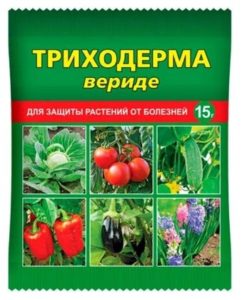
Trichoderma is just perfect for preventive treatments.
- Fitosporin (Bacillus subtilis strain 26 D, systemic pesticide of protective and curative action).
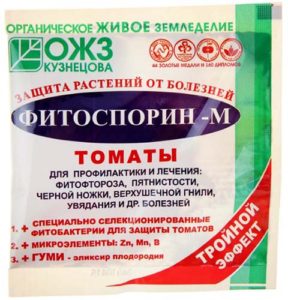
It is worth understanding! Biological agents are mostly recommended for prophylactic purposes, under unfavorable conditions and a high threat of late blight, or at very early stages of the development of the disease, when the lesion is still insignificant.
On the other hand, when tomatoes begin to ripen, it is very undesirable to use chemical preparations to combat late blight (especially if they have a long waiting period), so it is biological products that come to the rescue.
Folk remedies against phytophthora on tomatoes
Naturally, there are also folk remedies for fighting late blight on tomatoes, which were used by our parents, grandmothers and great-great-grandmothers.
Of course, their effectiveness is rather dubious (in other words, they are practically ineffective), but if you try and the result satisfies you, then great (but most likely, you just had good growing conditions), if not, then nothing surprising.
In the next video of the Procvetok channel, the presenter talks about the myths of using various pharmaceutical and folk remedies, which will be listed below.
Infusion of garlic
Perhaps this is the most universal and folk remedy for all diseases and even insect pests. You will need 100-200 grams of chopped heads of garlic, pour 1 liter of warm water, let it brew for 4-5 hours (some sources recommend up to a day). Then add another 9 liters of water, thus bringing it to 10.
By the way! For better adhesion, milk (250-500 ml) can be added to the solution.
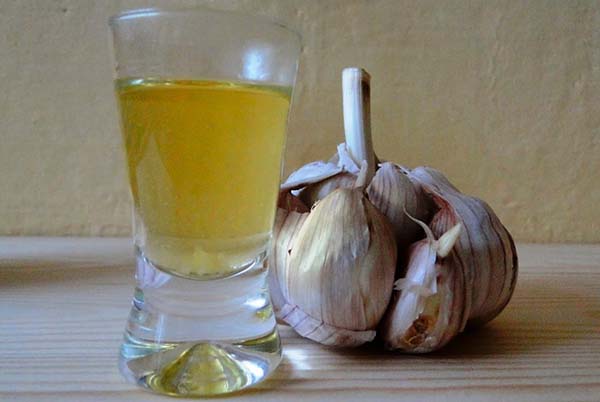
Milk serum
Sour milk whey should be diluted in half (i.e. 1 to 1) with water and preventive spraying should be started from the middle of summer.
Infusion of rotted hay
Actually, the meaning of this folk remedy is actually getting a hay stick, i.e. it is similar to application Fitosporin... You need to pour about 1 kg of hay with a bucket of water (10 liters), let it brew for 3-4 days, strain and start regular preventive treatments.
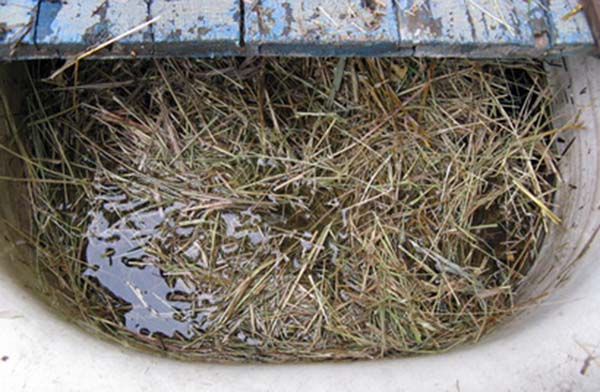
Ash dusting
This way you can powder wood ash near-stem circle (row spacing) of tomato beds to prevent the appearance of late blight.
By the way! Ash is also an excellent potash fertilizer.
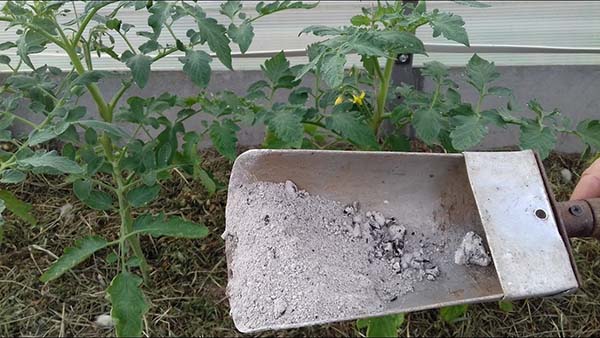
Soap-ash solution
100-200 grams wood ash pour 10 liters of hot water, bring to a boil. After the solution has cooled, strain and add 30-40 g of liquid soap.
Iodine and milk
To prepare the solution, you need to take 0.5-1 liter of milk for 10 liters of water, and also add 10-15 drops of iodine. Or hang open iodine bottles right in the greenhouse.
Important! According to the results of the experiment of the Procvetok channel, iodine is absolutely ineffective against late blight.

Interesting! To increase efficiency, some summer residents advise adding Trichopol to this iodine-milk solution (which, again, is pointless).
Trichopolus
Of course, where without pharmaceutical drugs! So, for processing, it is recommended to dissolve 10 tablets of Trichopolum (Metronidazole) in 10 liters of water.
Important! According to the results of the experiment of the Procvetok channel, the product is absolutely ineffective (even, on the contrary, phytotoxic), and the Tricho prefix does not in any way belong to the really effective Trichoderma product.

Zelenka (brilliant green)
Another absolutely useless remedy in the fight both specifically against late blight, and in general with all other fungal diseases.
By the way! A solution of brilliant green can be used for dressing seeds (1 tsp per 100 ml of water).
Flaxseed oil or fish oil
Another recipe for late blight of tomatoes and potatoes from the Procvetok channel: “To apply on the leaves, take 1-2 teaspoons of linseed oil or fish oil (5-10 ml; up to three tablespoons can be used, up to 50 g, if the risks of infection are very high, and the precipitation will take place earlier than 12 hours after applying the solution to the leaves) and thoroughly mixed with a soapy solution (40-50 g of laundry soap per 10 liters of water). Then it all dissolves in a bucket of water. Treat the leaves evenly, repeat after 2-3 weeks. It's nice to add to the solution boric acid (due to the small amount, it will not affect the soap), micronutrient dressings, potassium humate and other substances compatible with alkaline solutions (for example, Epin and pyrethroid-based insecticides are not compatible). "
Video: how to treat late blight of tomatoes and potatoes
Bath
And you can get acquainted with the following unusual way of dealing with late blight of tomatoes by watching the following video from the Procvetok channel:
Video: bath from phytophthora on tomatoes
Copper wire
Perhaps the most extravagant (and no less senseless) way to protect tomatoes from late blight.
Description from the author of the video: “The bottom line is to pierce the trunk of a tomato bush with a copper nail. At the point of contact of copper with tomato juice, copper oxide is formed, and this is nothing more than a drug (remedy) for fungal diseases. Circulating in the tops of a tomato, copper oxide protects the plant from late blight. "
Also in the comments they give an even simpler option: take a roll of bare copper wire and ordinary wire cutters, then strip and make an oblique cut on the wire. Then stick it into the stem of the tomato and bite off against the stem.
Video: copper wire from late blight on tomatoes
Thus, now you know how late blight is a serious and dangerous disease. Well, get ready for a tough fight, but remember that it is always easier to prevent a disease than to cure it later. Therefore, prevention and prevention again!
Video: late blight on tomatoes - how to detect and fight

